Tribological Behavior of Biomass Fast Pyrolysis Fuel and Diesel Blends
Abstract
:1. Introduction
2. Experimental
2.1. Material and Instrument
2.2. Structure and Principle of Tribometer
2.3. Data Acquisition
3. Results and Discussion
3.1. Preparation of Emulsion Biomass Fuel Blends
3.2. Physicochemical Performances of Emulsion Biomass Fuel Blends
3.3. Tribological Properties
3.3.1. Friction and Wear
3.3.2. Wear Mechanism
4. Conclusions
- (1)
- The physical and chemical properties of modified biomass fuel are greatly improved compared with the original biomass fuel; acid value, oxygen, and water content are reduced in varying degrees. The 5 wt.% modified biomass fuel with 0# diesel fuel blend basically meets the standard of vehicle fuel (GB 19147-2016).
- (2)
- The corrosion and wear characteristics of reciprocating friction pairs are also different due to the different content of biomass fuel in emulsified biomass fuel. With the increase in biomass fuel content, its friction reduction becomes better, but its wear resistance becomes worse. In the case of 5 wt.% emulsified biomass fuel, its friction reduction is slightly better than that of 0# diesel, and its wear resistance is equivalent to that of 0# diesel.
- (3)
- Some polar groups in the emulsified biomass fuel such as carboxylic acid are adsorbed on the metal rubbing surfaces to form a film with low shear strength, which prevents direct contact between metal surfaces and reduces the friction coefficient. On the one hand, with the increase in emulsified biomass fuel content the viscosity of lubricating oil will be reduced. On the other hand, some of the emulsified biomass fuels will produce some acidic substances during the friction process, which will cause corrosion on the surface of the friction pair and further increase the wear.
Author Contributions
Funding
Institutional Review Board Statement
Informed Consent Statement
Acknowledgments
Conflicts of Interest
References
- Chandran, D.; Gan, S.; Lau, H.L.N.; Raviadaran, R.; Salim, M.; Khalid, M. Critical relationship between biodiesel fuel properties and degradation of fuel delivery materials of a diesel engine. Therm. Sci. Eng. Prog. 2018, 7, 20–26. [Google Scholar] [CrossRef]
- Dey, S.; Reang, N.M.; Das, P.K.; Deb, M. A comprehensive study on prospects of economy, environment, and efficiency of palm oil biodiesel as a renewable fuel. J. Clean. Prod. 2021, 286, 124981. [Google Scholar] [CrossRef]
- Ikura, M.; Stanciulescu, M.; Hogan, E. Emulsification of pyrolysis derived bio-oil in diesel fuel. Biomass Bioenergy 2003, 24, 221–232. [Google Scholar] [CrossRef]
- Bertoli, C.; D’Alessio, J.; Del Giacomo, N.; Lazzaro, M.; Moccia, V. Running light-duty DI diesel engines with wood pyrolysis oil. Proceedings of International Fall Fuels and Lubricants Meeting and Exposition, Baltimore, MD, USA, 16–19 October 2000. [Google Scholar]
- Chiaramonti, D.; Bonini, M.; Fratini, E.; Tondi, G.; Gartner, K.; Bridgwater, A.V.; Grimm, H.P.; Soldairi, I.; Webster, A.; Baglioni, P. Development of emulsions from biomass pyrolysis liquid and diesel and their use in engines: Emulsion production. Biomass Bionergy 2003, 25, 85–99. [Google Scholar] [CrossRef]
- Mujtaba, M.A.; Kalam, M.A.; Masjuki, H.H.; Razzaq, L.; Khan, H.M.; Soudagar, M.E.M.; Gul, M.; Ahmed, W.; Raju, V.D.; Kumar, R.; et al. Development of empirical correlations for density and viscosity estimation of ternary biodiesel blends. Renew. Energy 2021, 179, 1447–1457. [Google Scholar] [CrossRef]
- Bai, X.Y.; Wu, J.; Wang, L.H. Preparation of emulsified fuel from biomass pyrolysis derived bio-oil and diesel and their use in engine. Trans. Chinese Soc. Agric. Mach. 2009, 40, 112–115. [Google Scholar]
- Fazal, M.A.; Sundus, F.; Masjuki, H.H.; Rubaiee, S.; Quazi, M.M. Tribological assessment of additive doped B30 biodiesel-diesel blend by using high frequency reciprocating rig test. Sustain. Energy Technol. Assess. 2021, 48, 101577. [Google Scholar] [CrossRef]
- Ajayi, O.O.; Lorenzo-Martin, C.; Fenske, G.; Corlett, J.; Murphy, C.J.; Przesmitzki, S. Bioderived Fuel Blend Dilution of Marine Engine Oil and Impact on Friction and Wear Behavior. J. Tribol. 2016, 138, 021603. [Google Scholar] [CrossRef]
- Awang, M.S.N.; Zulkifli, N.W.M.; Abbas, M.M.; Zulkifli, S.A.; Kalam, M.A.; Ahmad, M.H.; Yusoff, M.N.A.M.; Mazlan, M.; Daud, W.M.A.W. Effect of addition of palm oil biodiesel in waste plastic oil on diesel engine performance, emission, and lubricity. ACS Omega 2021, 6, 21655–21675. [Google Scholar] [CrossRef] [PubMed]
- Panepinto, D.; Viggiano, F.; Genon, G. Analysis of the environmental impact of a biomass plant for the production of bioenergy. Renew. Sustain. Energy Rev. 2015, 51, 634–647. [Google Scholar]
- Panepinto, D.; Viggiano, F.; Genon, G. The potential of biomass supply for energetic utilization in a small Italian region: Basilicata. Clean Technol. Environ. Policy 2014, 16, 833–845. [Google Scholar] [CrossRef]
- Yu, H.; Xu, Y.; Hu, E.; Liu, T.; Hu, X. The tribological behaviors of micro-emulsified bio-oil under reciprocating sliding condition. Tribology 2013, 33, 622–629. [Google Scholar]
- Yu, H. Investigation of Corrosive Wear Behaviours of Biomass Fuel. Master’s Thesis, Hefei University of Technology, Hefei, China, 2013. [Google Scholar]
- Du, M.; Huang, Y.; Shang, S. Study on optimum HLB value and physicochemical properties of diesel and bio-oil emulsions. J. Fuel Chem. Technol. 2009, 36, 679–683. [Google Scholar]
- Ouyang, H.; Lin, X.; Yuan, R. Research progress of microemulsion fuel oil. Renew. Energy 2006, 127, 55–58. (In Chinese) [Google Scholar]
- Tan, Y.; Wang, X.; Huang, W. Molecular orbital index criteria for lubricant property-interaction between polar groups and metal surface. Tribology 2000, 20, 280–283. [Google Scholar]
- Xu, Y.; Wang, Q.; Hu, X.; Zhu, X. Preparation and tribological performance of micro-emulsified bio-oil. Acta Pet. Sin 2009, 25, 53–56. [Google Scholar]
- Desale, G.R.; Gandhi, B.K.; Jain, S. Effect of erodent properties on erosion wear of ductile type materials. Wear 2006, 261, 914–921. [Google Scholar] [CrossRef]
- Hu, X.; Xu, Y.; Wang, Q.; Jiang, S.; Zhu, X. Tribological performance of distilled biomass-oil from rice straw by pyrolysis process. J. Synth. Lubr. 2008, 25, 95–104. [Google Scholar] [CrossRef]
- Lu, X.; Cotter, J.; Eadie, D.T. Laboratory study of the tribological properties of friction modifier thin films for friction control at the wheel/rail interface. Wear 2005, 259, 1262–1269. [Google Scholar] [CrossRef]
- Roman, K.; Barwicki, J.; Hryniewicz, M.; Szadkowska, D.; Szadkowski, J. Production of Electricity and Heat from Biomass Wastes Using a Converted Aircraft Turbine AI-20. Processes 2021, 9, 364. [Google Scholar] [CrossRef]
- Song, R.; Yu, H.; Song, H.; Hu, X. Effects of biomass fast pyrolysis fuel on the tribological behaviour of heavy-duty diesel engine lubricating oil. Appl. Sci. 2022, 12, 2360. [Google Scholar] [CrossRef]
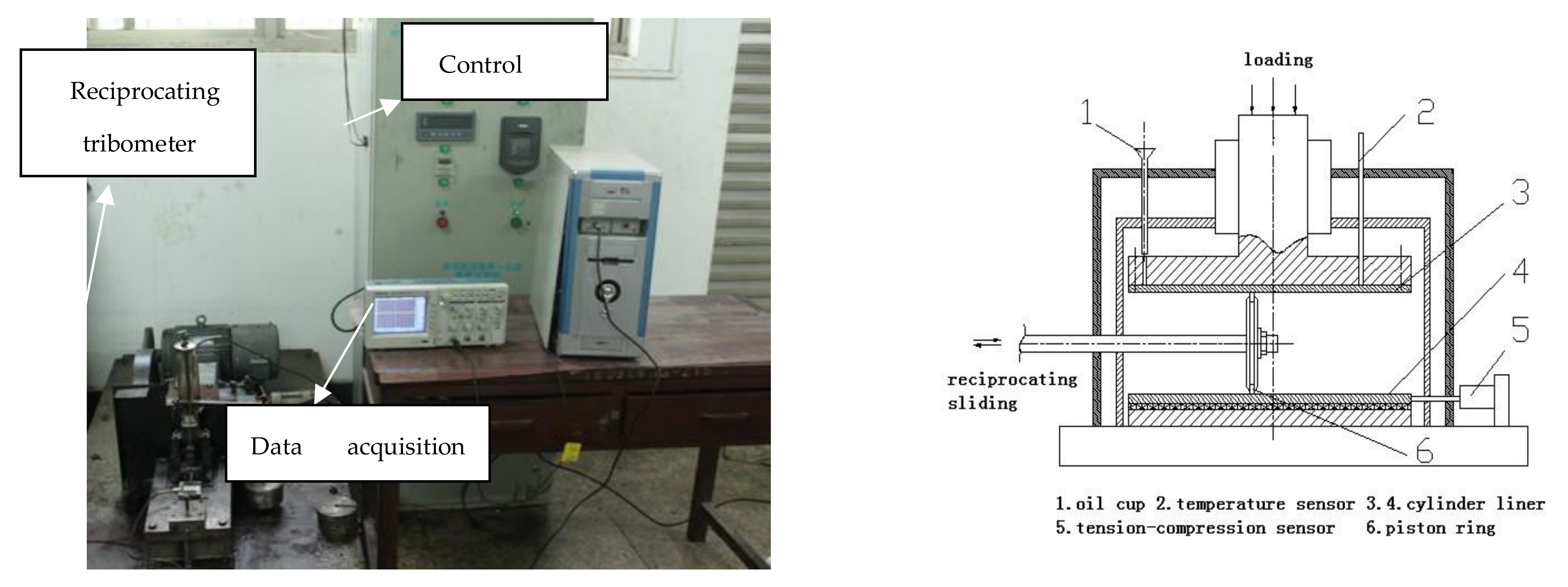
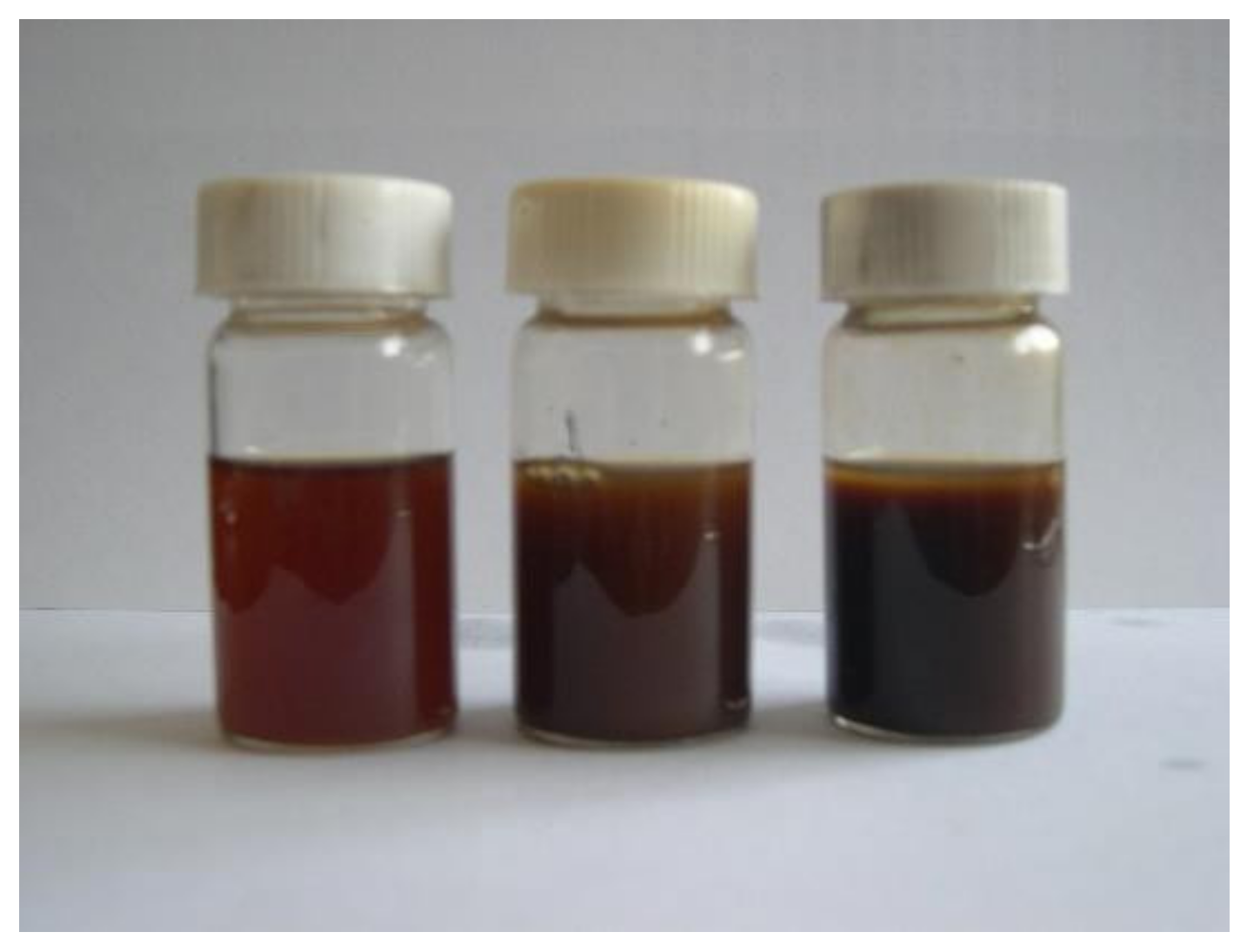
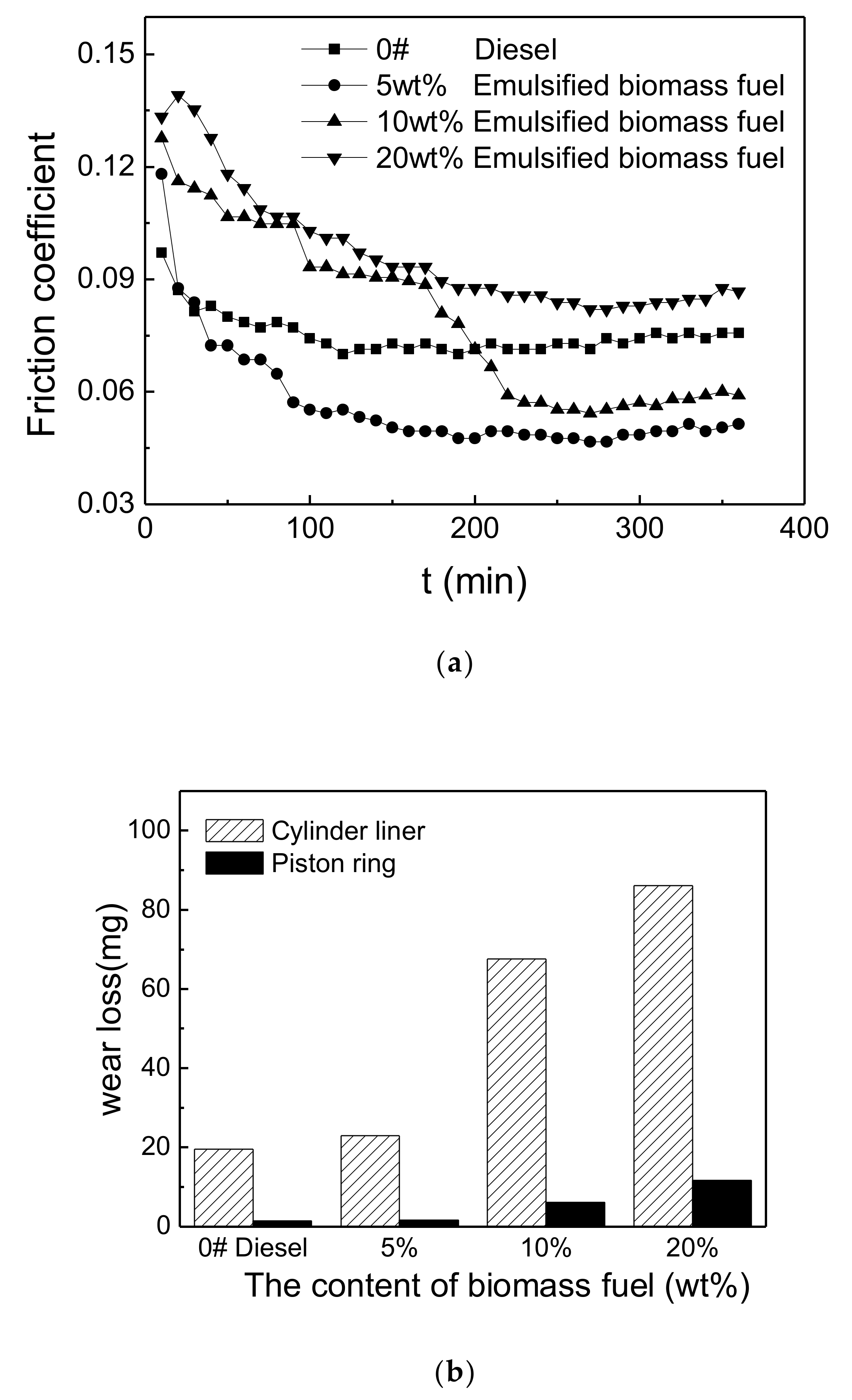
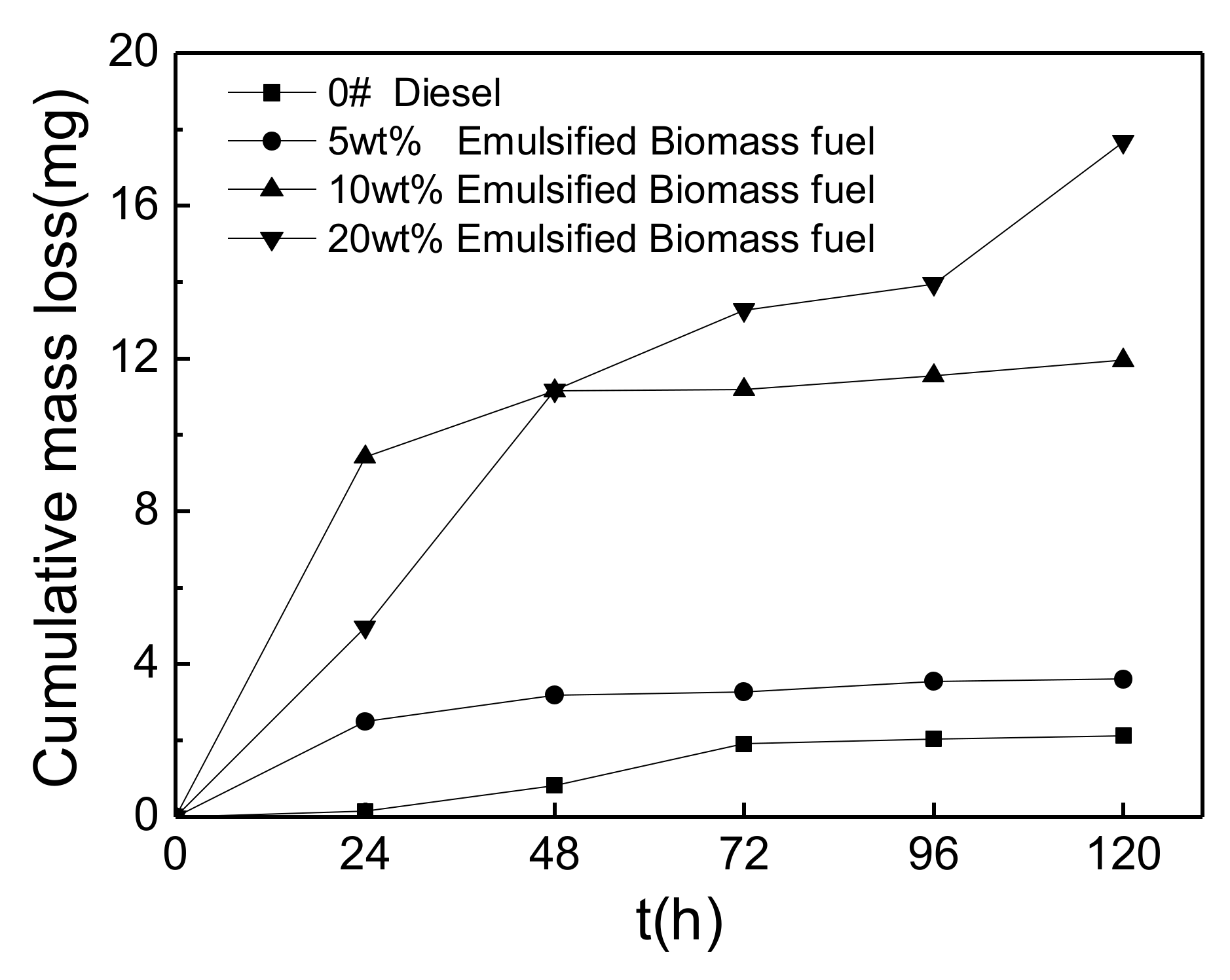
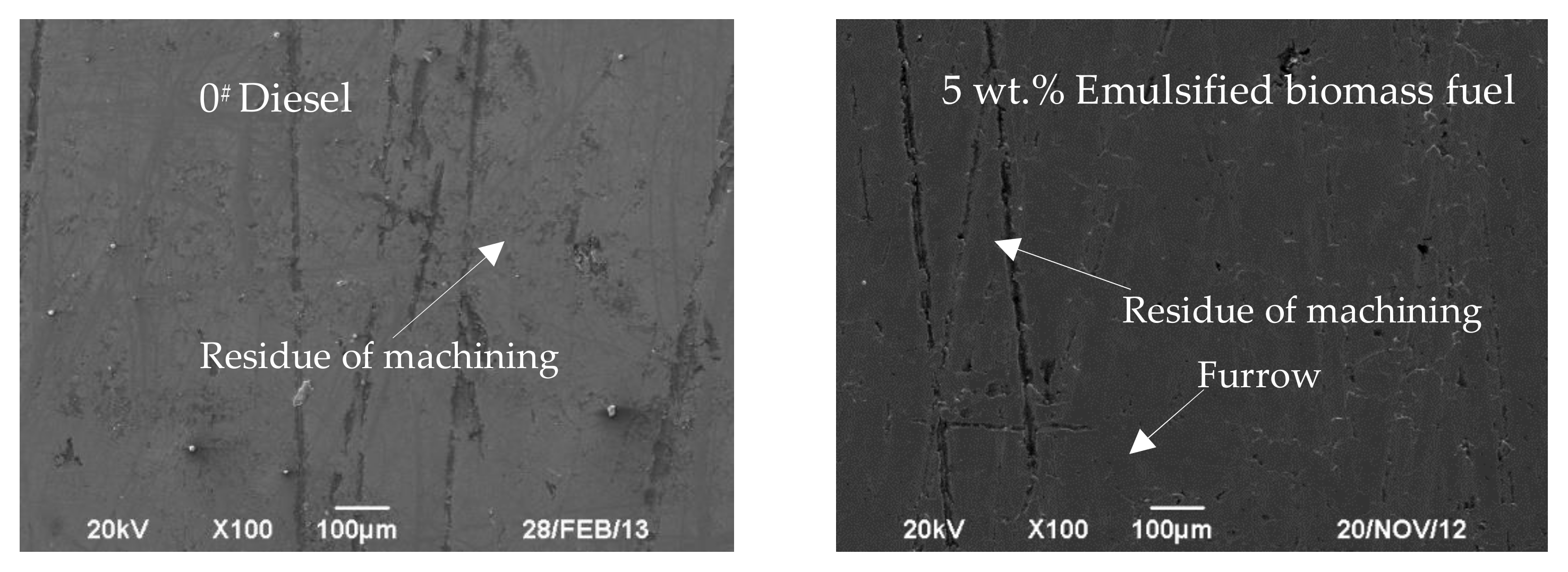

| Emulsion Biomass Fuel | Temperature (°C) | Stirring Time (min) | Additive Content (wt.%) | Rotation (r/min) |
|---|---|---|---|---|
| 5 wt.% | 30 | 20 | 5.5 | 1500 |
| 10 wt.% | 65 | 80 | 3.0 | 1500 |
| 20 wt.% | 65 | 120 | 4.0 | 1500 |
| Items | 0# Diesel | Biomass Fuel | 5 wt.% Emulsion Biomass Fuel | 10 wt.% Emulsion Biomass Fuel | 20 wt.% Emulsion Biomass Fuel |
|---|---|---|---|---|---|
| C (m/m)/% | 85.55 | 32.35 | 82.42 | 80.05 | 75.58 |
| H (m/m)/% | 13.49 | 8.36 | 13.23 | 12.72 | 10.22 |
| O (m/m)/% | 0.66 | 58.06 | 3.99 | 6.83 | 13.56 |
| Calorific value/(MJ·kg) | 47.25 | 17.15 | 45.91 | 41.61 | 36.44 |
| Density (20 °C)/(kg·m3) | 737.80 | 862.60 | 778.16 | 789.49 | 805.31 |
| Viscosity(40 °C) /(mm2·s) | 2.71 | 2.10 | 3.09 | 3.33 | 3.91 |
| Freezing point/°C | −15 | <−58 | −14 | −16 | −19 |
| Surface tension (20 °C)/(mN·m) | 31.1 | 37.6 | 33.7 | 34.0 | 35.1 |
| Acid value /(mg·KOH·g) | 0.12 | 33.10 | 0.82 | 1.21 | 1.88 |
| Water (vol)/% | less | 24.50 | 1.35 | 2.45 | 4.42 |
| Varied Blends | Element (wt.%) | |||||||
|---|---|---|---|---|---|---|---|---|
| C | O | Fe | Mn | Cr | Si | P | S | |
| 5 wt.% | 1.86 | 6.39 | 86.07 | 1.06 | 0.36 | 3.43 | 0.81 | |
| 10 wt.% | 2.99 | 16.08 | 70.98 | 1.26 | 0.50 | 6.77 | 1.43 | |
| 20 wt.% | 7.25 | 24.78 | 55.26 | 1.07 | 0.43 | 9.98 | 0.67 | 0.56 |
Publisher’s Note: MDPI stays neutral with regard to jurisdictional claims in published maps and institutional affiliations. |
© 2022 by the authors. Licensee MDPI, Basel, Switzerland. This article is an open access article distributed under the terms and conditions of the Creative Commons Attribution (CC BY) license (https://creativecommons.org/licenses/by/4.0/).
Share and Cite
Song, R.; Yu, H.; Song, H. Tribological Behavior of Biomass Fast Pyrolysis Fuel and Diesel Blends. Appl. Sci. 2022, 12, 2540. https://doi.org/10.3390/app12052540
Song R, Yu H, Song H. Tribological Behavior of Biomass Fast Pyrolysis Fuel and Diesel Blends. Applied Sciences. 2022; 12(5):2540. https://doi.org/10.3390/app12052540
Chicago/Turabian StyleSong, Ruhong, Huiqiang Yu, and Hui Song. 2022. "Tribological Behavior of Biomass Fast Pyrolysis Fuel and Diesel Blends" Applied Sciences 12, no. 5: 2540. https://doi.org/10.3390/app12052540





